Total Pageviews
Wednesday 18 December 2013
Bionym’s Vision For A Future Where Secure Account Holders Are Their Own Credentials
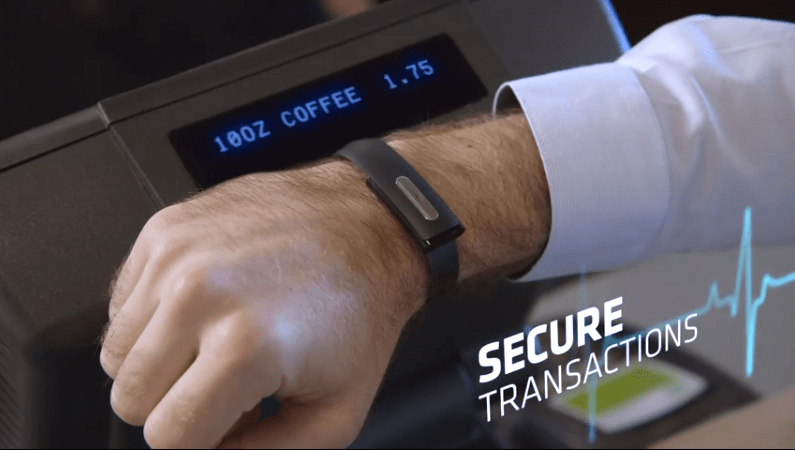
Toronto-based Bionym turned heads with its concept for wearable hardware that authenticates a user based on their heartwave signature, which could turn the whole world of digital security on its head. It’s a key tied to your person in a very intimate sense, meaning it can’t really be stolen or lost like even a current standalone unique passkey generator can.
We met with Bionym CEO and co-founder Karl Martin at their headquarters in Toronto, where the engineering team shares relatively limited space with the rest of the folks. The team is growing at a rapid clip, however, and the plan is to move into a more accommodating space in the near future. As it stands, however, it’s kind of nice to see people soldering and testing brand new circuit boards right next to those arranging future partnerships and doing developer outreach.
Martin filled us in on the progress his startup has made since launchings its pre-order campaign back in September, and it sounds as if things are on track. Final design is still mostly up in the air, but as you can see, things have come a long way from the original prototype that Martin and his co-founder Foteini Agrafioti developed first only roughly a year ago. It’s also very interesting to hear Martin articulate exactly where he sees Nymi’s tech headed – including a long-term goal where it becomes a wearable you won’t even notice you’re wearing.
via TechCrunch » Startups http://feedproxy.google.com/~r/techcrunch/startups/~3/-xZ4hpFIvqU/
Select Ting customers can now enjoy Sprint's Spark LTE

President appointed panel recommends scaling down NSA powers, cease collection of Americans' phone records

Regala porvenir, dona médula ósea
Para hacerte donante de médula ósea sólo es necesario que tengas buena salud, que tu edad esté entre 18 y 55 años, y que estés dispuesto a hacerte un análisis de sangre para estudiar tus características de compatibilidad.
Las posibilidades de que te llamen son de una entre quinientas, así que lo más probable es que no suceda nunca. Pero si sucede podrás ayudar a intentar una vida a cambio de unas pequeñas molestias.
Y eso sí que es un buen regalo, tanto para el donante como para el receptor.
via Microsiervos http://www.microsiervos.com/archivo/mundoreal/regala-porvenir-dona-medula-osea-.html
Microsoft pulls Surface Pro 2 update after reports of battery and installation problems

Which Tablet Do You Want This Holiday Season?

Study proves that you can secretly hijack an older Mac's webcam

Why iRobot's CEO Welcomes Our New Google Robot Overlords

Touchless music game lets you create jittery drum and bass with your face

AMC's Yeah! interactive streaming movie service comes to iPad tomorrow

Crowdfunding: Figure Out What Success Looks Like And Plan Backwards From There

This is a guest post by Sam Beck, creator of Helium, a super capacitor-powered speaker, as part of our ongoing coverage of crowdfunding in real-world situations.
This is what happened during my first crowdfunding project, which is currently sitting at 97% of its goal with two days left on the clock. Our campaign’s goal was to cover the launch cost of our first product, a supercapacitor-powered portable speaker which would cost about $8,000 in compliance & overhead costs. The next time I do something like this, I’m going to make a giant poster of that baseline number – $8,000 or whatever it is – and hang it right in front of my face. The biggest mistake I made during this campaign was forgetting that number.
Here’s how I messed up.
About 90% of my planning was very realistic. I built a simple, conservative model, and set the variables so that if things went according to plan, we would make a bit of money on top of covering those costs. And then, I started imagining what it would be like to make two times the goal, or ten times. We almost failed because while there was a definite goal, I was thinking about a different number. That is my biggest takeaway from the whole project. There is only one goal; your objective is to meet it. Everything else is gravy.
So that’s the first half of success in crowdfunding: know what success looks like. So this is how to plan once you know what you’re planning for.
The first thing is to see what your market looks like. 4 First Names has built an awesome set of open source tools to see the shape of your potential market – a very pretty Unity 3D visualization of the data from Kickstarter. They also scraped all the data from every Kickstarter project to make it work. Each dot is a project – the bright diagonal is the fact that projects that get close tend to meet their goal.

The visualization is cool, but having the data from every project is awesome. For our working data set, we took the whole list and filtered it down to only Product Design and Technology projects that had raised over $2000, of which there were 2085. We were pretty sure we’d get over $2000 in pledges from friends and family on day one – if you can’t hit 5% of your goal within your private network, you are probably in a bad spot.
Now, with this list of similar projects, we used simple statistics to think about our funding goal. 45% of these projects with goals $25-$35k were successful vs. only 35% of projects with goals $36k-50k. Getting even more specific, within audio projects, only 21% of projects aiming for over $30k have been successful.
We settled on $30k as a goal, believing that our idea was in the top quartile of audio projects in terms of how much interest, media coverage, and organic traffic it would generate.
With an idea of the goal in mind, it was time to set prices. We started out our price planning with a simple survey, run through Facebook & SurveyMonkey. It cost about $20 – but if I were going to do it again, I’d probably use SurveyMonkey’s paid audience feature instead of Facebook ads to (hopefully) get a better sample.
Our survey used the Van Westendorp method: show potential customers the product, explain it, and then ask for four prices from each respondent, in order:
2. Too cheap to believe in
3. Getting expensive
4. Great value
Take the set of answers for each question, graph them in rank order, and you end up with a set of four curves that show how much people are or are not willing to pay.
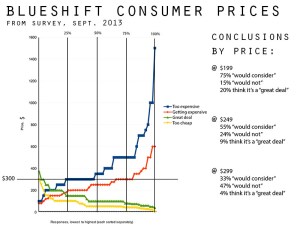
This helped to validate our initial guess that $300 was a pretty good price that many people would be willing to pay. It also showed how much demand would drop off as the price increased – in the neighborhood of 30% less demand for each $50 price increase.
This survey gave us a slope for our demand curve, but no reference point. So we put together this chart: reward prices vs. number of backers from 12 related Kickstarter audio projects. It was enough to make an educated guess about how many units we might sell. This still left a continuous range of possible price and goal coordinates – the final decision was based on where I thought the product should be priced in the long term.
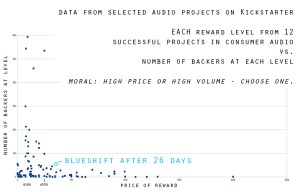
Now we had informed guesses on a plausible funding goal, a plausible unit retail price, and how many units might sell at a given price. We knew our overhead costs and our per unit costs, including US shipping and 8% fees (3% credit card + 5% for the site). So we built a simple model and tweaked the pricing and goal until we would break even at the funding goal.
This is where I made the big mistake.
My idea on pricing was to have prices increase through the campaign. I remain convinced this is a good idea, but I messed up the implementation. The prices need to convince people they are getting a good deal, but they also need to present a sense of urgency.
Initially the campaign was set up with 25 pledges at the first level (best price / earliest delivery). These sold out in six days, which was pretty good, about what I had hoped for. Then the price went up to the second tier (+$50), and the campaign came to a dead stop.
The problem was that my carrot-stick pricing model was off. A $50 discount (carrot) was indeed a strong incentive to buy early, but conversely a strong disincentive to buy later. If demand had been high enough that the second tier (100 units) started selling out quickly, maybe it would have worked – but instead, it just sat there, telling people there was no need to buy today because there were 97 left.
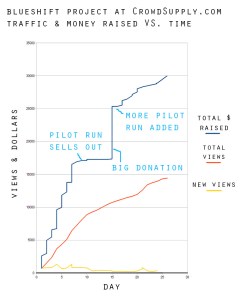
This probably would have killed the campaign completely, but we got a large cash donation on day 16, which allowed us to subsidize/add more pledges at the carrot level. Moral: if you’re going to do tiered pricing, make sure the tiers are small enough that they start filling in quickly! I thought that having a nominal ‘regular price’ as a stick would help to push the middle tier along, but the tier had to many slots for the stick to be credible.
The last part, and probably the hardest part, is planning for traffic. I initially thought we needed to get 10,000 hits on the site to make the goal – turns out it was really more like 20,000. Our conversion rate at present is about 0.5%. Most of those conversions ultimately come from Facebook and direct traffic, but very few originated from Blueshift’s Facebook posts.
It was serious a challenge to get enough media coverage. Doing this again, I would find a way to build demo units to send to the press – otherwise, you’re basically asking people to write about your press release (no matter how many times you reword the email). The only times that the campaign is “news” are the first day, the day you make your goal, and the last few days. Use those days wisely and reach out early. When you are not a news item, you need to find alternative means of generating traffic.
We got a fair amount press, about 30 postings – but each bit of coverage brings only a small number of visits, and a smaller number of sales. I was surprised to see how few clicks some coverage generated: for example this article on Digital Trends got 650 likes on Facebook, but only 350 clicks to our CrowdSupply page.
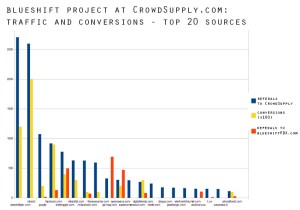
We were really lucky to get a big donation – if that had not happened, the project would have been effectively dead a few weeks ago. If I were going to do this again, I would have left out the international option, which would have saved us some money – we could have set a lower goal, and we have very few international pledges.
Beyond that, making this work took me being a full-time marketer/internet fiend for about two months. Honestly, I just want to get the product built – but I don’t know of another way I could have gotten the money together, so we’ll call it a victory. Assuming it has gotten funded by the time you read this.
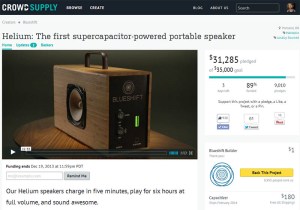
via TechCrunch » Startups http://feedproxy.google.com/~r/techcrunch/startups/~3/cXSDx_J-2LM/
Meizu plans to begin selling smartphones in the US next year

Updated Vine for Windows Phone lets you save clips as drafts

Tres paseos espaciales para reparar el sistema de refrigeración de la Estación Espacial Internacional
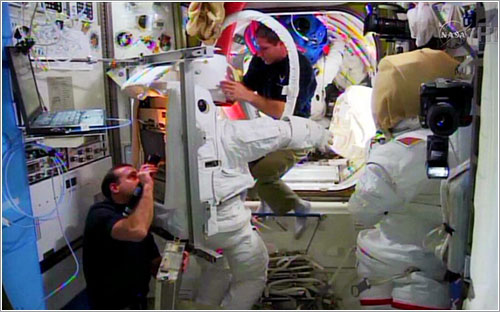
Hopkins y Mastracchio preparando los trajes espaciales
Aunque desde el control de la misión estaban trabajando en un parche de software para controlar la temperatura del bucle de refrigeración externo A del segmento estadounidense de la Estación Espacial Internacional en el que falló una válvula la semana pasada dejándolo fuera de servicio los responsables de la misión han decidido que esto no se arregla por software y que lo que hay que hacer es cambiarla.
Así que han programado tres paseos espaciales, cada uno con una duración prevista de seis horas, que Mike Hopkins y Rick Mastracchio llevarán a cabo el 21, 23 y 25 de diciembre durante los que su objetivo es retirar el Módulo de Bombas S1 en el que está la válvula estropeada y sustituirlo por uno de los tres repuestos que hay a bordo, tal y como puede leerse en NASA Postpones Orbital Launch, Sets Spacewalks to Repair Faulty Pump Module .
En 2010 Tracy Caldwell Dyson y Doug Wheelock tuvieron serios problemas para cambiar otro módulo igual por el que está instalado ahora mismo y al final necesitaron para ello tres paseos, de ahí que se hayan programado otros tres para esta ocasión, aunque Hopkins y Mastracchio utilizarán, de todos modos, procedimientos modificados respecto a los que usaron Dyson y Wheelock, con lo que lo mismo arreglan todo con dos paseos, que era los que estaba previsto que necesitaran Caldwell y Wheelock en 2010.
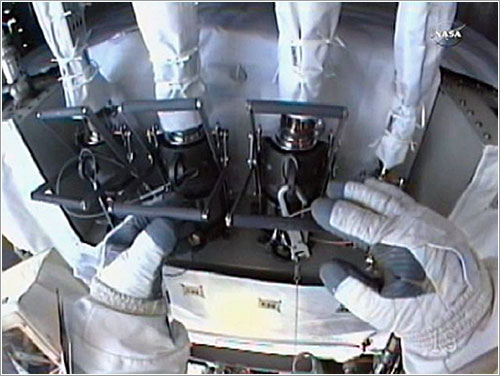
Los conectores rápidos del módulo de bombas dieron bastantes problemas en 2010
De todos modos en la NASA aún no las tienen todas consigo tras la fuga de agua en el traje espacial de Luca Parmitano el pasado mes de julio, por lo que las tareas y desplazamientos de estos paseos están pensados para poder volver rápidamente al interior de la EEI si fuera necesario, así que esto lo mismo ralentiza el trabajo de Hopkins y Mastracchio, de ahí también que hayan dejado hueco para ese tercer paseo.
El del 21 será el primer paseo espacial de Hopkins, aunque para Mastracchio será el séptimo; lleva ya acumuladas 38 horas y media en paseos espaciales.
Desde el interior de la Estación les asistirá Koichi Wakata usando el Canadarm 2, lo que les vendrá de perlas, ya que el módulo que tienen que sustituir mide 175×127×91 centímetros y pesa unos 354 kilos.
La tarea que tienen que realizar entra dentro de las que se conocen como «de contingencia», lo que quiere decir que aunque no estén programadas los astronautas se preparan para ellas, con lo que no se puede decir que se trate de paseos espaciales de emergencia.
La decisión de proceder con la sustitución del módulo implica además que finalmente el lanzamiento de la primera misión regular de una cápsula de carga Cygnus a la EEI haya quedado pospuesto hasta enero de 2014.
via Microsiervos http://www.microsiervos.com/archivo/ciencia/tres-paseos-espaciales-para-reparar-sistema-refrigeracion-estacion-espacial-internacional.html
Challenge Your Favorite Athletes to Video Game Battles With OverDog

First alien moon possibly spotted 1,800 light years away

Google Glass update brings The Wall Street Journal, storm warnings and RSS to your face

Hey Uber, Lyft Is Growing Faster Than You
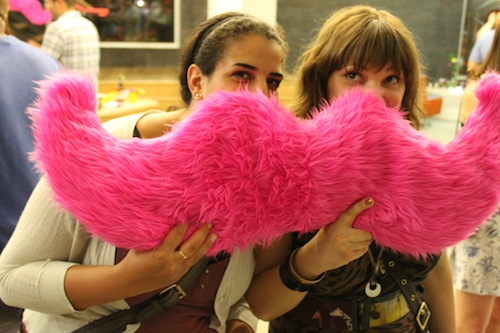
Uber’s revenue numbers, which were leaked to Gawker just a few weeks ago, look bold at roughly $20 million per week.
But there isn’t necessarily a definitive market winner yet in the peer-to-peer space, as the entire field is on a rising tide. Lyft, which started peer-to-peer ride-sharing after Uber’s black cars on demand, is seeing its revenues grow at a rate of about 6 percent every single week, according to raw data and revenue dashboards that Lyft co-founder John Zimmer shared exclusively with TechCrunch.
That growth rate is more than double Uber’s growth pace, which averaged about 2.8 percent in the five weeks of data leaked to Gawker. Compounded over a year, Lyft is seeing 20X growth.
“I think there will be a black car winner at the high end and a peer-to-peer winner at the affordable price point for the mass market,” Zimmer said. “Lyft is already the leader in peer-to-peer, which is the fastest growing on-demand transportation segment.”
You could argue that because Lyft is growing from a smaller revenue base, its growth rate would naturally be higher. But Lyft says it is already doing one-third of the weekly ride volume Uber was doing across all of its product lines when they raised their last round at a $3.5 billion valuation (if you back out Uber’s leaked numbers to June 2013).
Zimmer’s data and revenue dashboards last week revealed a more than $100 million gross run rate.
Uber, for its part, says that growth rates vary drastically in different seasons, with the summers being slower than the holiday season. So they argue you can’t extrapolate growth rates back.
“I’d love to tell you how much bigger we are than them, but I can’t do that,” said Uber CEO Travis Kalanick. “We’re the leader right now, but we take competition seriously. We don’t dismiss it.”
We estimated Uber’s gross revenue run rate at $1 billion from the leaked Gawker dashboard. But they don’t just do peer-to-peer ride sharing. They have multiple product lines covering black cars, taxis, peer-to-peer ride-sharing and SUVs. Uber is also international, covering 66 cities in 24 countries, compared to Lyft’s U.S.-based 20 markets. (Lyft also doesn’t do 7X surge pricing.)
Then there is a slew host of other companies competing to offer on-demand transportation from your phone like Sidecar, Hailo, Gett, and China’s Didi Dache.
But these competitors are generally much smaller than Lyft and Uber, which are fighting for peer-to-peer in the U.S. market. It’s not clear from Uber’s leaked numbers how big their peer-to-peer business is compared to the original black car or taxi business lines. Kalanick declined to break this out, but he said black car fares are generally only 1.8 times as high as the peer-to-peer fares.
The competition between the two companies has become increasingly cutthroat, with Uber resorting to aggressive campaigns to undercut Lyft’s supply of drivers. They’ve offered $50 gas vouchers to recruit Lyft drivers and have run advertising campaigns urging drivers to “Shave The Stache.”
Kalanick defended these tactics, “It’s important for us to have as much supply as possible. When you’re small, you don’t need that many drivers to make it work. But when you’re big, you’re talking about taking in thousands, if not tens of thousands of drivers. It’s important that if there are good drivers out there, they know they have options.”
Amidst Uber’s more competitive tactics, Lyft has stayed focused on growing its core community of drivers and users without poaching from rivals.
“By focusing on community, we’re able to attract the highest quality drivers. It makes sense that our competitors would try to recruit them as they try to catch up in peer-to-peer, but we’re not seeing an impact on our loyal driver base or our ride growth numbers.” said Zimmer, who added that the “Shave the Stache” campaign actually ended up educating more prospective passengers and drivers about Lyft.
via TechCrunch » Startups http://feedproxy.google.com/~r/techcrunch/startups/~3/tr4bc4nv6tE/
This Chromium experiment takes the URL out of the address bar, because why not?

Pebble Smartwatch to Get Its Own App Store in Early 2014

Twitter's story coming to a TV near you, thanks to 'Hunger Games' producer

El uso de los dispositivos electrónicos en todas las fases del vuelo llega a Europa con British Airways
We're the first European airline to allow the use of handheld personal electronic devices throughout the entire flight.
— British Airways (@British_Airways) diciembre 18, 2013 Han tardado un poco más de lo que habían anunciado, pero al final la Agencia Europea de Seguridad Aérea ha publicado su normativa acerca del uso de dispositivos electrónicos en vuelo y Britis Airways ha sido la primera aerolínea europea en apuntarse.
En los Estados Unidos fueron JetBlue y Delta con pocas horas de diferencia.
La norma europea, disponible en Personal Electronic Devices on board (PED) , es básicamente un calco de la aprobada por la Autoridad Federal de Aviación de los Estados Unidos: se pueden usar los dispositivos electrónicos personales en cualquier fase del vuelo, siempre que estén en modo avión, y aquellos mas grandes como los portátiles tienen que estar convenientemente guardados durante el despegue y el aterrizaje propiamente dichos.
Igual también que en los Estados Unidos, cada aerolínea es libre de modificar sus propias normas de acuerdo con este nuevo reglamento si y cuando lo estime oportuno, teniendo que notificarlo a la autoridad competente en su país en cuanto decida hacerlo.
via Microsiervos http://www.microsiervos.com/archivo/aerotrastorno/uso-dispositivos-electronicos-en-todas-fases-vuelo-llega-a-europa-con-british-airways.html
Mention Becomes A Full-Fledged Media Monitoring Tool With Buffer Integration
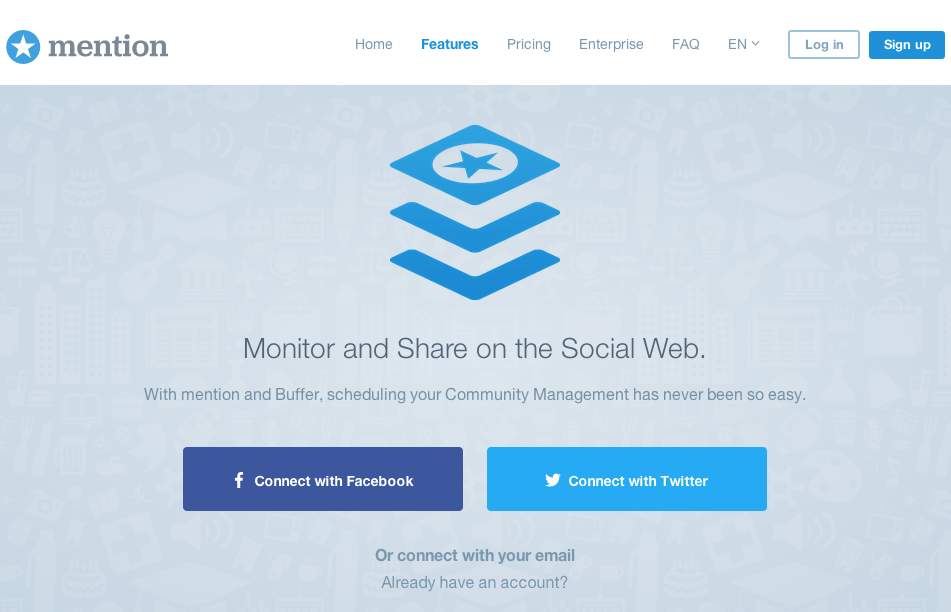
French startup Mention just received an important update that should make it more compelling to its user base. Whenever Mention users receive a new alert, they can share it on their social channels using Buffer, lining up status updates to share later. As a reminder, Mention is a media monitoring tool that works a lot like Google Alerts with a web interface to skim through your alerts. It is mostly targeted toward business users.
While there was a way to tweet and share individual alerts on Facebook, you had to do it manually throughout the day. With today’s update, you can spend a few minutes every now and then to see all your alerts regarding your company or product, and decide what to share. Then, everything will happen automatically — your social feeds will stay active with updates about what you are doing.
Combining Mention with Buffer makes a lot of sense. Mention’s strengths were its monitoring tools, not its social features. Instead of making a Buffer copycat to fill this gap in the product offering, it partnered with Buffer. In the meantime, Buffer users will be able to get an alert stream right from the Buffer dashboard.
So far, Mention has attracted 150,000 users and 2,500 paying subscribers, including CrunchBase, GitHub or Microsoft. It is tiny compared to Buffer’s 1 million users, but media alerts feel more like a niche product — the new partnership will help both user bases grow. The company has received $800,000 in seed funding. Converting more users to its paying plan will probably be the next challenge for the startup.
via TechCrunch » Startups http://feedproxy.google.com/~r/techcrunch/startups/~3/kBlYWcEbFdY/